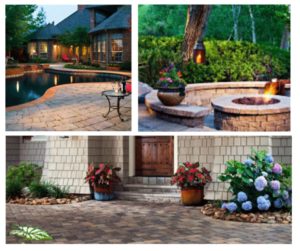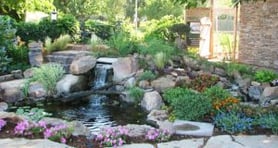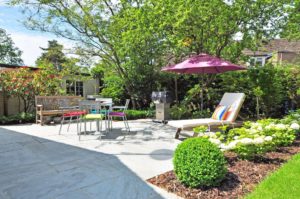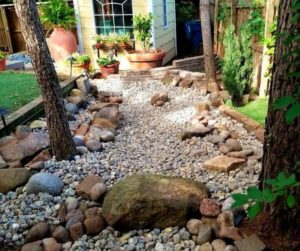Lawns are less popular than they once were. Nowadays designers, architects, and consumer trends are moving towards more efficient solutions that are environmentally friendly and add curb appeal. Landscape rocks are one of them, combining durability, versatility, and style.
How To Use Rocks in Your Landscaping Project
Decorative landscaping rocks come in more colors and styles than you may be familiar with. The giant lava rocks of the 80s are a thing of the past, and zen gardens are only one of many options. You can use decorative rocks to give surprisingly warm and cozy looks, take a naturalistic approach, or go towards sleeker landscaping materials for a modern, minimalist style.
Let’s get into some of the many ways you can use rocks and stones to embellish your outdoor spaces. 
Walkways, Paths, Edging & Stepping Stones
There are many ways to incorporate decorative stone to your pathways: nice, crunchy gravel or river stones are an option that will engage all of your senses, making that pleasant noise when you walk on it. If you prefer silence, flagstone is a great option to be used as natural-looking pavers that will guide your steps along the garden.
Exposed dirt is prone to sprouting weeds, and will also splash your plants and paths with mud during rainy seasons. Cover those edges with natural stone or beach pebbles for a neat look that will showcase your plants to their best advantage and keep the mud at bay when it rains.
Soil, Erosion Control, Ground Cover & Mulch
Old-school gardeners often relate “mulch” with wood chips or other organic material. But mulch doesn’t necessarily have to be organic in origin. Anything that can be used to cover the soil to protect it from erosion, manage weeds and regulate temperature can be considered mulch.
There are many pros to using rocks as mulch, and durability is one of them: while wood chip mulch has to be replaced twice a year, rocks and stones need no replacement, and they will not discolor or suffer any changes in appearance. If you expect mulch to also enrich your soil, just remember to increase your fertilizing schedule a little to make up for the change. Your plants will be just as happy and weed-free.
Gardens and Ponds
Grass is lovely groundcover, but it is also expensive, high maintenance and a terror when it comes to water use. Think of the many beautiful options that decorative landscaping rocks offer: beach pebbles can be a great canvas in which to showcase your collection of agaves and desert plants, and chipped rock comes in varying sizes and colors to set off a rose garden, a fern collection, fruit trees or whatever is the pride of your garden.
Ponds benefit especially from decorative landscaping rocks: river rocks and beach pebbles are naturally suited to water and will make your ponds and other water features incorporate seamlessly into their surroundings with a serene, natural look.
Decorative
 Decorative landscaping rocks can serve various purposes, as we just saw, but let’s not underestimate their beauty. Rocks and stones can be a feature all by themselves, or add to the beauty of your garden, highlighting your prized plants and bringing light into dark corners.
Decorative landscaping rocks can serve various purposes, as we just saw, but let’s not underestimate their beauty. Rocks and stones can be a feature all by themselves, or add to the beauty of your garden, highlighting your prized plants and bringing light into dark corners.
If you want to know which are our most popular decorative rocks, and how you can use them to enhance your spaces, take a look at Minick's Top 9 Best Sellers Blog.
What Is the Best Stone for Landscaping?
The short answer is “it depends”.
There is no “best decorative stone”, but there is definitely a “best decorative stone for YOU”. Once we take into account your geography and climate, architectural style, type of garden, and the effect you want to achieve, the choices will narrow and it will be easy for you to make a confident choice.
Read our "how to choose landscaping rock" blog post for some rock solid advice.
What is the Most Durable Decorative Rock?
This is a great question, and the answer is simple: It’s all durable.
Decorative stone won’t fade, its colors won’t change, and it doesn’t need replacing. All you need to do is hose it down occasionally. In the long run, you save a lot of money in upkeep, maintenance, and replacement.
Choose the Right Stone Solution for Your Purpose
We’ve talked a lot about style, color, and mood, but let’s not forget the size, shape, and purpose of the stone. Do you want it to drain well and prevent erosion? Use larger rock sizes to hold slopes in place or under stormwater collection zones. Is it going to be walked on by humans or pets? A smaller size is recommended to prevent twisted ankles.
Remember that broken stone is man-made, so you can choose the size you need for your project.
It's Not So Much About the Stone--- It's the Installation
Once you have found the right decorative rocks and stones, think carefully about the installation. If there is a chance of weeds sprouting under your stone you may want to invest in some landscaping fabric to roll out underneath, to keep it tidy. For water features, erosion control or borders, you may also want to consider digging a small trench to hold your rocks in place.
What is the Most Affordable Decorative Stone?
Let’s talk about money. How much does decorative rock cost? Depending on the type of rock, you may find prices starting at less than $100 per ton (about 75% of a cubic yard), which will cover about 81 square feet, 3" deep. This means you could pay $1.23 per square foot covered, or even less.
How much does a ton of river rock cost? How much is landscape rock per ton? What about granite? You can always review our pricelist if you’re thinking about a specific product.
Here are some additional tips to get the best value for your money when buying landscaping materials.
Stay Open About Color and Size for Lower Prices
Choice comes at a price, especially if what you want has to be ordered or fabricated especially. The more specific you are about your color, specs, and size, the more you have to pay to have it made or brought.
Consider that a local store buys a few types of decorative stone in bulk so they can pass on those savings to their customers. If you keep your mind open, you may find something you like at a much better price!
Consider Long Term Costs Too
Traditional Bermuda sod for a lawn can be about the same price as the cheapest decorative rock, but you must consider that lawn has many maintenance costs after purchasing and installing it. You will have to install a watering system and be prepared for the water bill during summer. There’s mowing, too, and looking after the grass - it is, after all, a living groundcover.
Rocks are drought friendly, require no watering, mowing or maintenance. They won’t turn yellow or look sad if you neglect them. Your investment in decorative landscaping rocks will look good year-round with minimum effort and zero additional expenses after you install it.
Budget-Friendly Decorative Rocks
Here’s another good idea: use decorative rock where you might use concrete, for example, walkways and driveways. Concrete usually starts at $6/yd, so gravel or natural stone is more cost-effective.
What's Trendy in Landscape Stone?
Decorating with rocks and stones is a rising trend in the market, and architects and designers are constantly coming up with stylish and interesting ways to use gravel and rocks. We have compiled the top 5 Trends to Watch in this blog - read more and discover new and great ways to design with stone.
Decorative Stone for Traditional Design
The lawn is best crew, together with the this is how we’ve always done it posse are naturally skeptical about using decorative rock, fearing it may look cold, too modern, dead or clinical. Nothing is farther from the truth. There are many warm-toned rocks such as aztec, as well as natural stone and clean river rocks, which have varieties of color that makes them beautiful and inviting to look at.
Decorative Stone for Modern Design
That said, stone will allow you to go as modern as you like - crushed white marble is super trendy right now, and it is great for reflecting light and illuminating spaces. Forget about old-fashioned red or black lava rock, and consider instead beautiful salida river rock with its grays and whites and appealing texture.
Another design trick is to use two different types of rocks to delineate a pathway or section of your garden. Slate, granite, and desert gold have very different color palettes, and you can create high contrast by arranging them side by side.
Looking for a Timeless Design?
If you're looking to do a decorative rock installation that won't go out of style in two years, consider timeless classics such as granites and crushed rocks in neutral white, tan, and taupe colors; aztec in a beautiful color story of browns and tans; or river pebble in soothing organic grays and browns.
The Pros and Cons of Landscaping Rocks
The main consideration when choosing your stones or rocks is the size - make sure it is adequate for the use you want to give it. Here are some pointers.
Large Decorative Stone
Rocks of a certain size are very uncomfortable to walk on, and this can be a good thing: use them to restrict traffic on areas where you don’t want people or pets treading! Larger rocks are also ideal for drainage purposes, and their weight means they will not be blown or washed away easily, making for a more stable landscape.
To be fair, larger rocks are harder to install and sometimes more difficult to clean, and they may limit your plant choices since smaller plants will be dwarfed by the bigger rocks. Taller and bigger plants can hold their own next to large rocks and look very dramatic.
Small Decorative Rock
Smaller and medium-sized rocks have the opposite perk: they are easy to walk on, and compact well to give you smooth driveways and walkways. They are gentle on your dog’s paws, and they will not compete with your smaller plants and shrubs. They are also easier to clean with water and a hose, just be careful not to move them around too much or make sure to shove them back in place after a pressure wash.
How Much Stone Do I Need for My Garden?
As a very rough guide, a ton of most of our decorative landscape rocks will cover 80 sq. ft., 3" deep. For more detailed info, take a look at our blog post on stone coverage.
How to Install Decorative Rock
How much is decorative rock going to cost to install? Well, you can do it the easy way or the cheap way.
Landscapers
We don’t do installations ourselves, but we are always happy to recommend landscapers we know and trust. Professional installation comes with an expense, but also with a warranty and peace of mind. If the job requires digging or has technical difficulties, we recommend leaving it to the experts and saving yourself from back injuries.
DIY
Sometimes all you want is to roll out some weed blocker and spread some gravel, and we will not discourage you!
Weed well before you cover with stone, practice work safety (boots and gloves please!) and know your limits when it comes to moving heavy wheelbarrows.
How to Find Decorative Rock Near You
Are you ready to get some decorative stones and spread them all over your place? Great! You have several options to purchase your landscaping materials.
Big Box Stores
While big-box megastores are many people’s first choice, because they are convenient and familiar, keep in mind that in order to offer you everything under the sun they must limit the variety in each category. You will find good prices, but there will be scant options compared to a store that specializes in landscaping materials.
Local Landscape Supply Stores
A specialized landscape supply store will offer you a much better selection than a big-box store, and they are more likely to have special sales or be willing to negotiate a better price. Staff is trained specifically on decorative rocks and they will have better knowledge of their product, as well as offer you a warm customer service experience, suggestions for your project or help to solve your problems.
Minick Materials Ships Decorative Stone Nationwide
Want to know more about us and what we do? Read about our history and passion for landscaping materials, and drop us a line to talk about your projects.







![All About Soil Compaction: Causes, Challenges & Solutions [A Guide]](https://www.minickmaterials.com/hs-fs/hubfs/Imported_Blog_Media/plants-2411458_1920-1024x683.jpg?width=725&name=plants-2411458_1920-1024x683.jpg)
.webp?width=725&name=AdobeStock_462076409%20(1).webp)